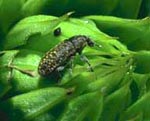 Rhinocyllus conicus Frölich
Rhinocyllus conicus Frölich
[Coleoptera: Curculionidae]
Biology | History | Status | Management | Weeds | Literature | Links
Adult R. conicus are dark brown in color and 10 to 15 mm long. Each female lays about 100 to 200 eggs on the bracts of thistle heads. Eggs hatch in 6 to 9 days and newly hatched larvae feed through the bracts into the receptacle. Developing larvae feed on the receptacle and the young seeds, reducing or preventing the production of viable seeds. There are four larval growth stages which last about 4 to 6 weeks. Pupation occurs in a black oval cell inside the thistle head, and requires another 7 to 10 days. Adults emerge from seed heads in July and August in more northern locations and in June and July in Texas. They remain inactive during the summer and then hibernate through the winter. The following spring adults emerge from winter shelters to lay eggs on the developing buds. There is one adult generation per year.
Thistle head weevil has been released and established in many parts of the United States over the last 20 years. Research in other states shows a 50 to 95 percent reduction in the number of thistles after weevils have become established. The decline in thistle populations is gradual over several years, and some resurgence of the weed may take place. Resurgence of thistles can be caused by dumping soil containing seeds onto a site, exposing soil containing thistle seeds during tillage, overgrazing that creates bares patches of soil where thistle seeds can germinate, or temperature fluctuations during the winter which kill many overwintering weevils. Cool temperature also inhibit weevil activity. Resurgence of thistles is temporary, however, established weevils eventually gain control.
The first weevils were released in Texas, near Kerrville in 1987. Establishment of thistle head weevil was first confirmed in 1992. At that time they had dispersed only about 1.5 miles from the release site. This site in Kerrville is the most southerly location where this weevil is established in North America. Establishment at Kerrville is particularly significant because the thistle blooming period is about one month earlier there compared with most other locations in the United States. Since 1992, weevils have been released at other sites in the Hill Country, near Dallas, and at Hereford. (See complete report.)
R. conicus had been highly successful in controlling musk thistle after an establishment period of 5-6 years. In locations where weevils can multiply rapidly, a dramatic decline in musk thistle may be possible in as little as 2 to 3 years. This successful biological control of musk thistle is partly due to the good synchronization of plant growth and insect activity.
Biological control of musk thistle can best be implemented by taking the following steps:
1. Select release sites. An appropriate site is any dense patch of thistles that will not be disturbed for 3 to 5 years after the release. Select a site where cattle will not be grazing because cattle interfere with thistle head weevil activity.
2. Obtain starter colonies of thistle head weevils. Spring emerging R. conicus can be collected at established sites in April before they complete egg laying. Use a beating sheet and an aspirator to collect adult weevils as they feed on thistles and lay eggs in the heads. Contact your county Extension agent or the Extension entomologists for information about local release and establishment efforts. Thistle head weevils are also available from a few commercial sources.
3. When weevils are received, keep them in a cool place (less than 80 degrees F) because high temperatures will kill them. Paper cartons with tight lids are appropriate for holding and transporting weevils. Release them as soon as possible.
4. Release a minimum of 300 to 500 weevils per site depending on the size of the thistle infestation. Starter colonies are best released when thistles have elongated and buds have formed. Release adult weevils among dense thistle patches away from traffic and in non-windy areas near trees or shelter. Release weevils in the evening, not during the hottest time of the day. For widespread thistle infestations, release weevils at a number of sites.
5. Monitor weevil establishment. Make additional releases only if weevils fail to become establishment. Make additional releases only if weevils fail to become established.
Along with biological control:
1. Establish a good stand of an adapted grass.
2. Avoid overgrazing or unnecessary plowing that would expose barren land.
3. Cut small infestations of thistles before they produce seed.
The thistle head weevil primarily attacks musk thistle and other members of the genus Carduus. However, strains of the weevil are known to attack milk thistle, Silybum marianum (Boldt and DeLoach 1985). Recently concern about Rhinocyllus attacking other thistle species has become controversial. When use of this weevil became a concern, the relocation efforts were discontinued in Texas.
Boldt, P. E., and C. J. DeLoach. 1985. Evaluating Rhinocyllus conicus Froel. (Coleoptera: Curculionidae), an introduced weevil for the biological control of Carduus and Silybum thistles. Bull. Entomol. Soc. Amer. 26: 355-358.
Boldt, P. E., and J. A. Jackman. 1993. Establishment of Rhinocyllus conicus Froelich on Carduus macrocephalus in Texas. Southwestern Entomologist 18(3): 173-181.
Jackman, J. A., P. Boldt, J. W. Stewart and T. W. Fuchs. 1992. Biological Control of Musk Thistle in Texas. L-5067. Biological Pest Control. Texas Agricultural Extension Service. Texas A&M University System, College Station, TX.





